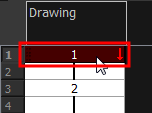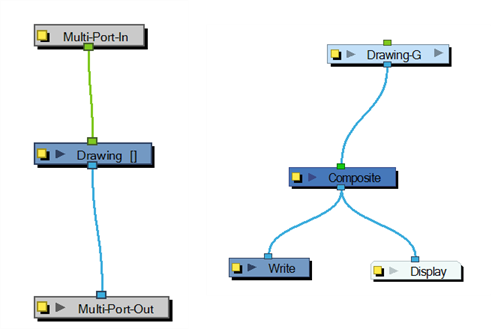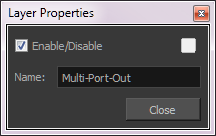- Modules
- In Front and Behind Arm Animation
- Activity 2: About Multi-Port Nodes and Duplicated Drawings
Activity 2: About Multi-Port Nodes and Duplicated Drawings
T-ANIMCO2-002-002
In this topic, you will learn about the Multi-port node concept and what it is used for. You will also learn about drawing substitution and duplicated drawings to create the illusion that a portion of a limb is moving in front or behind another drawing.
If you want to modify a drawing that already exists, but keep the original drawing intact, you can duplicate the drawing and work on the copy. When duplicating a drawing, the selected cell is replaced with the new drawing. The exposure of the original drawing that was on the current cell is removed. The original drawing is not deleted from the project folder or other cells in which it is exposed.
With Toon Boom Harmony Premium, you can create a keyframe at the same time as you duplicate your drawing. This way, you can modify and reposition drawings without affecting the original drawing.
Material
To complete this topic, you will need the following from the sample material you downloaded:
- MO-ANIMCO2-002/01_Layers and Multiports.tpl
- MO-ANIMCO2-002/02_Layers and Multiports.tpl
How to duplicate a drawing
- In the Timeline or Xsheet view, select the drawing to duplicate.


- Do one of the following:
| ‣ | From the top menu, select Drawing > Duplicate Drawings. |
| ‣ | Right-click and select Drawings > Duplicate Drawings. |
| ‣ | In the Xsheet toolbar, click the Duplicate Drawing |
| ‣ | Press Alt + Shift + D. |

Multi-Port Nodes
A Multi-Port-Out node is added in a new Group node by default. Use it to add output ports to the Group node so that you can output the result of the group operation to the rest of the network. After you plug an element to a Multi-Port-Out node, an output port appears on the bottom of your Group node. You can add additional output ports as needed.

A Multi-Port-Out is automatically added when you create a group.
Use the Multi-Port-Out editor to rename the node in the network.

A Multi-Port-In node is added by default in a new Group node. Use it to add one or more input ports to the Group node so that you can process an image through the nodes in the Group node.
When you plug an element to a Multi-Port-In node, an input port appears at the top of the Group node. You can add additional ports to the nodes as needed.
Pass your cursor over the Group node input port to see the name of the Port Image In node that it connects to. You will notice that the Group node in these examples has no output port. It requires a Multi-Port-Out node to output data from its network.
A Multi-Port-In is automatically added when you create a group.
Use the Multi-Port-In editor to rename the node.

- Stacey Eberschlag
- Senior Solutions Specialist
- toonboom.com
Author
Next Topic
Activity 3: Posing the Animation
Time Estimated 10 mins
Difficulty Level Intermediate
Topics List
- Activity 1: Activity Overview
- Activity 2: About Multi-Port Nodes and Duplicated Drawings
- Activity 3: Posing the Animation
- Activity 4: Copying and Pasting Layers
- Activity 5: Modifying Artwork
- Activity 6: Creating Empty Drawings
- Activity 7: Adjusting the Timing